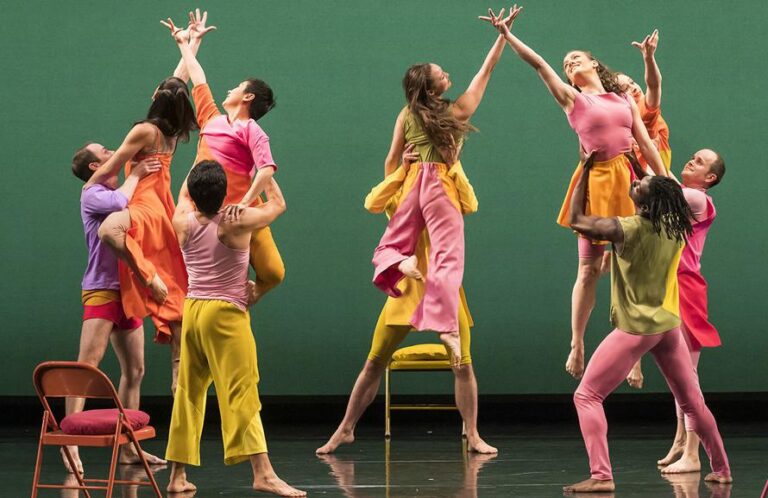Dance Review
THE LOOK OF LOVE
Performed by Mark Morris Dance Group. Presented by Global Arts Live. At Emerson Cutler Majestic Theatre, Thursday. Repeats Saturday and Sunday. Tickets $58-$95. 617-876-4275, globalartslive.org
Mark Morris Dance Group was last here in 2019 with “Pepperland,’’ a salute to the 50th anniversary of the Beatles’ “Sgt Pepper’s Lonely Hearts Club Band.’’ This weekend, in a Global Arts Live presentation, the troupe is back with “The Look of Love,’’ which pays tribute to the late Burt Bacharach and his longtime lyricist, Hal David. Thursday at the Emerson Cutler Majestic Theatre, MMDG delivered a fluffy fun romp that glances at love but doesn’t look very hard.
As opposed to “Pepperland,’’ which incorporated just five songs from “Sgt Pepper,’’ “The Look of Love’’ packs 14 Bacharach-David numbers into its 59 minutes. I have no quarrel with Morris’s selection, and I didn’t really expect to hear “(The Man Who Shot) Liberty Valance’’ or “What’s New, Pussycat?,’’ but the omission of hits like “Make It Easy on Yourself,’’ “Only Love Can Break a Heart,’’ “Blue on Blue,’’ “Close to You,’’ “You’ll Never Get to Heaven (If You Break My Heart),’’ and “This Guy’s in Love with You’’ testifies to the depth of the Bacharach-David songbook.
The show, which premiered at Brooklyn Academy of Music in 2022 and was presented at Jacob’s Pillow in 2023, begins with MMDG musical collaborator and pianist Ethan Iverson playing “Alfie.’’ Broadway star and lead vocalist Marcy Harriell was unable to perform Thursday due to illness; background vocalists Blaire Reinhard and Clinton Curtis filled in capably. Iverson on piano was joined in the pit by Jonathan Finlayson (trumpet), Simón Willson (bass), and Vinnie Sperrazza (drums).
Even without the lyrics, “Alfie,’’ in Iverson’s imaginative arrangement, is sad and wistful, something a choreographer could sink his teeth into. The actual dance opener, however, is “What the World Needs Now.’’ Five women and five men enter dressed in Isaac Mizrahi’s rainbow-colored unisex tunics, tights, shirts, trousers, shorts, skirts, and one very nice orange gown, bringing with them the “set,’’ five folding chairs in pink and lemon cream with matching cushions. Forming a charmed circle in couples, they embody the communal, democratic, utopian Morris ethos, changing partners, waltzing, executing modest lifts, raising their arms in invocation and imprecation and celebration, offering themselves to the gods or to the universe. They hop and skip and prance and promenade like exuberant schoolkids out for recess.
The lyrics of “I’ll Never Fall in Love Again’’ give a choreographer more to work with; here the dancers push off one another, walk away while dangling an inviting hand, pretend not to answer the phone. Mime in Morris is always a curse and a blessing, often clever, sometimes just cute. The Kentucky bluebirds in “Message to Michael’’ flap their wings and fly to New Orleans; getting pneumonia in “I’ll Never Fall in Love Again’’ has everybody sneezing. They use the chair cushions as makeshift umbrellas and skip past puddles in “Raindrops Keep Falling on My Head.’’ They hold their noses against the LA smog in “Do You Know the Way to San Jose’’ and then, sleeping and puffing, they mime, “Dreams turn into dust and blow away.’’ They put on their makeup in “I Say a Little Prayer.’’
There’s some actual hoofing: tours en l’air, barrel turns, a fleeting entrechat. As the one dancer in “Raindrops’’ who’s “free,’’ Domingo Estrada Jr. channels his inner Gene Kelly. Dallas McMurray gets to show off in “Don’t Make Me Over’’; Courtney Lopes and Noah Vinson serve up an affecting duet in “The Look of Love.’’ But one song seems much like the next; the movement has the look of generic, even in the striding patterns of “Walk on By,’’ where the walkers reverse course rather than going on by. Partnering is mostly episodic and inconsequential; the dancers look out at us or up to the heavens more than they do at each other. At various times the choreography gets upstaged by Finlayson’s trumpet, Iverson’s piano, and the vocals.
Morris conveys the anguish of “Anyone Who Had a Heart,’’ which sees Estrada crawling on the floor, and finds the humor in “The Blob’’ (yes, Bacharach composed the theme to this 1958 sci-fi horror film), where against Nicole Pearce’s dark-red lighting the dancers advance menacingly on the audience, brandish the folding chairs, and eventually move like zombies. But the closer, “I Say a Little Prayer,’’ returns to upbeat and uplifting. The dancers slap their arms to their sides in a gesture signaling “forever’’; then re-create, after a fashion, the circle of “What the World Needs Now.’’ It’s not the greatest look, but these days we need all the prayers, and the love, we can get.
Jeffrey Gantz can be reached at jeffreymgantz@gmail.com.


